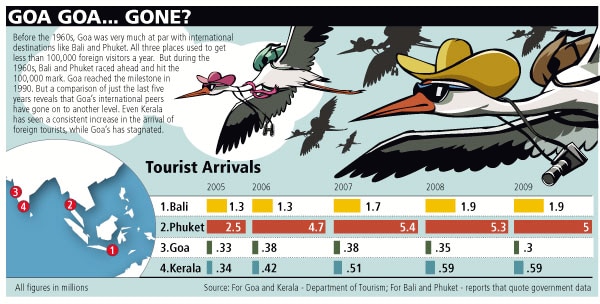
Goa: Paradise Lost
Goa is gradually losing its allure as a favoured destination among foreign tourists. It now needs to change its basic offering beyond sun-and-beach to win them back
Jan van Djik looks weather beaten. It looks as if he spent a good part of his 67 years strolling on Calangute beach. The Dutchman has been following a 20-year ritual of visiting Goa twice a year. Except that over the last few years, he has been spending less and less time there. “Doing a lot of travel in other parts, especially in the North… Benares.”
It was travellers like Djik who made Goa the destination that it is. Tourists from sun-starved European countries escaped to Goa to avoid the brutal winter. Sipping beer, smoking marijuana or just playing a game of beach cricket, they bankrolled Goa’s tourism economy. The hotels, beach shacks, restaurants, two-wheeler hire guys, all made money.
But today it has all spun out of control. Goa is seeing a sharp drop in foreign tourist arrivals compared to other popular Indian destinations like Agra, Jaipur and Kerala. It is also fast losing its billing as an international tourist haven. Most of its competitors, like Bali in Indonesia and Langkawi in Malaysia, have shown impressive growth in 2009. Even upcoming options like Sri Lanka and Vietnam are getting more feelers from European tourists, industry players say (see graphic).
Goa used to get one out of five foreign tourists coming to India. But the 2009 winter season (the peak season, traditionally from October to March) has seen the second consecutive drop in incoming foreign tourists after the dramatic plummet in 2008 — something that the local industry says has happened for the first time.
“This year it looks like the season has got over by mid-January,” says Cruz Cardozo, president of the Goa Shack Owners Association. Various estimates put the total overseas tourist arrivals in 2009 at 300,000, down from about 350,000 a year earlier and about 380,000 in 2007.
Sure, other popular Indian destinations, too, have suffered, but Goa has suffered more. According to tourism ministry, arrivals to India fell by 3.3 percent in 2009. That is marginal compared to Goa government’s official figure of a 13 percent drop; the local industry estimates a more than a 30 percent dip.

















